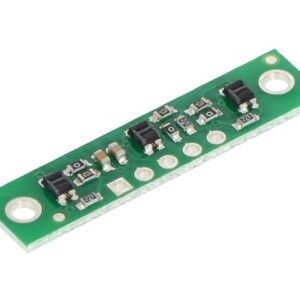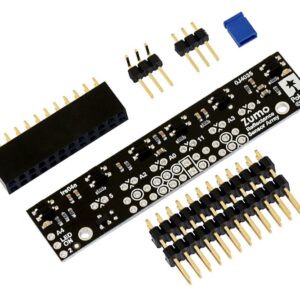$360.00 MXN (IVA Incluido)
10 disponibles
Este módulo sensor tiene 8 pares de IR LED/fototransistores montados en un paso de 0,375″, por lo que es un gran detector para un robot. Los pares de LEDs están dispuestos en serie para reducir a la mitad el consumo de corriente y un MOSFET permite que los LEDs se enciendan fuera de las opciones de detección o el poder de ahorro adicionales. Cada sensor proporciona una salida de tensión analógica separadas.
Localización: C3
| Peso | 0.05 kg |
|---|---|
| Fabricante | Pololu |
| Descuento | 5 o más $342.00 |
10 disponibles
El conjunto de sensores de reflectancia QTR-8A está diseñado como un sensor de línea, pero se puede utilizar como un sensor de proximidad o de reflectancia de uso general. El módulo es un soporte conveniente para ocho pares de emisores y receptores de IR (fototransistores) espaciados uniformemente a intervalos de 0,375″ (9,525 mm). Cada fototransistor está conectado a una resistencia pull-up para formar un divisor de voltaje que produce una salida de voltaje analógico entre 0 V y VIN (que normalmente es 5 V) como una función del IR reflejado. Un voltaje de salida más bajo es una indicación de una mayor reflexión.
Las salidas son todas independientes, pero los LED están dispuestos en pares para reducir a la mitad el consumo de corriente. Los LED están controlados por un MOSFET con una compuerta normalmente alta, lo que permite apagar los LED configurando la compuerta MOSFET a un voltaje bajo. Apagar los LED puede ser ventajoso para limitar el consumo de energía cuando los sensores no están en uso o para variar el brillo efectivo de los LED a través del control PWM.
Las resistencias limitadoras de corriente de LED para el funcionamiento a 5 V están dispuestas en dos etapas; esto permite una simple derivación de una etapa para habilitar el funcionamiento a 3,3 V. La corriente del LED es de aproximadamente 20-25 mA, lo que hace que el consumo total de la placa sea de poco menos de 100 mA.
Existen varias formas de interactuar con las salidas del QTR-8A:
Este último método funcionará si puede obtener una alta reflectancia de su superficie blanca, pero probablemente fallará si tiene un perfil de señal de menor reflectancia.
Nuestra biblioteca AVR Pololu proporciona funciones que facilitan el uso de estos sensores con nuestros controladores de robot Orangutan; consulte la sección Sensores de reflectancia QTR de nuestra referencia de comandos de biblioteca para obtener más información. También tenemos una biblioteca Arduino para estos sensores.
Si no necesita o no puede colocar los ocho sensores, puede dividir dos sensores y seguir utilizando los 8 sensores como dos módulos separados, como se muestra a continuación. La PCB se puede marcar desde ambos lados a lo largo de la perforación y luego doblar hasta que se separe. Cada una de las dos piezas resultantes funcionará como un sensor de línea independiente.
Este módulo se entrega con una tira de conectores de 0,1″ de 25 pines y una resistencia de orificio pasante de 100 ohms.
Puede dividir la tira de conectores en piezas más pequeñas y soldarlas a su matriz de sensores de reflectancia como desee, o puede soldar cables directamente a la unidad o usar una tira de conectores en ángulo recto para una instalación más compacta. Los pines del módulo están dispuestos de modo que se pueda acceder a todos ellos utilizando una tira de 11 × 1 o una tira de 8 × 2.
La resistencia es necesaria para que la matriz de dos sensores funcione después de que la matriz original de ocho sensores se divida en dos piezas. Esta resistencia solo es necesaria una vez que se ha roto la placa.





